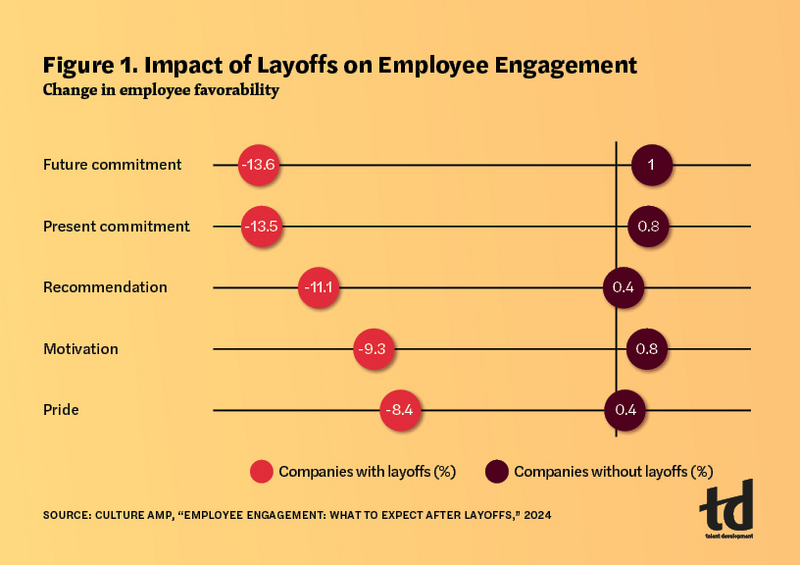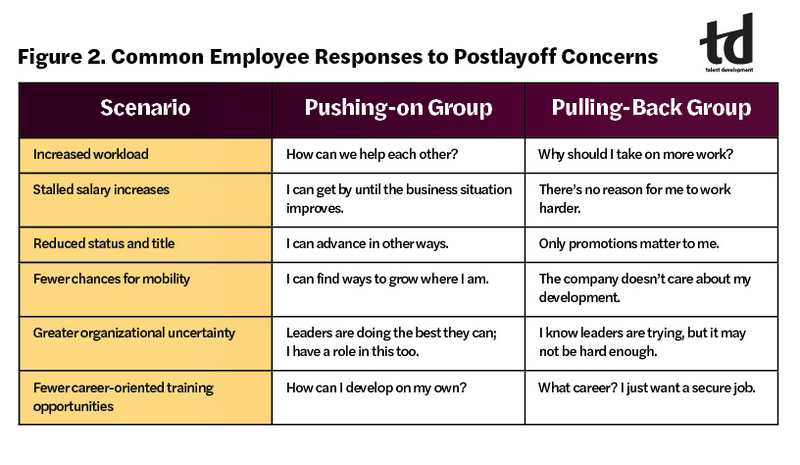TD Magazine Article
Considerations After Cutbacks
What strategies can help retain and engage the “survivors” of a company layoff?
Mon Jun 03 2024

Bookmark
What strategies can help retain and engage the survivors" of a company layoff?
Recent headlines make it clear that many professionals have received—or soon will receive—pink slips. Consider these news summaries:
At least 48,000 employees at US-based technology companies have lost their jobs so far in 2024, according to a Crunchbase News tally.
Companies laid off more than 305,000 US workers in 2023 in a series of mass layoffs that started, most notably, with technology companies but then spread across industries, Forbes reports.
Nike announced it expects to incur $400 million to $450 million in employee severance costs as it lays off more than 1,600 workers, according to Fast Company.
There is one group in those scenarios that employers often overlook: The staff who remain after a layoff. In many ways, of course, the kept-on workforce is in a better situation—but also one that deserves special attention from company leadership. It's time to look seriously at why those individuals require special attention and what the talent development function can do to keep them "keepin' on."
Survivor island
Surviving a round of layoffs can be debilitating for the individuals who remain employed. They can suffer from survivor's guilt, low morale, concern about job security, and the burnout that comes from taking on additional tasks and responsibilities.
Within the kept-on workforce are two groups that respond differently to the same circumstance. One group comprises staff who push on despite the negativity, demonstrating resilience by staying upbeat and honing or expanding their skills. They are valuable assets to their companies but also know that there are other options out there, which makes them a flight risk.
The other group comprises workers who pull back, lacking the skills or resilience to deal effectively with change. They experience an alarming drop in employee engagement (see Figure 1) and are a drag on productivity and morale.
In fact, according to Glassdoor's 2024 Workplace Trends research, "In the 30 days following a layoff, employers' overall rating drops 4 percent ... Additionally, overall ratings stay that low, even 180 days after the layoffs." Further, Glassdoor found that "ratings for Culture & Values and Work-Life balance continue to decline another 3 and 4 percent respectively during the 150 days following the initial 30-day drop. While the impact on Culture and Work-Life Balance may not be immediately felt after a layoff, there can be an ongoing impact from longer-term burnout, weaker employee culture and persistent employee disengagement that employers must be aware of."
Not your parents' job market
Employees today have a different perception of their relationship with work than they had before the pandemic. People's priorities have shifted; workers now have a much stronger sense of what they want in a job. A scan of recent surveys regarding what employees want indicates that their key requirements include:
Flexibility in work arrangements
Support for well-being, burnout prevention, and work-life balance
Opportunities for advancement
Work that is personally fulfilling
With the tremendous changes in the job market during the past few years, staff know that if their current employer won't provide at least some of their desires, then another employer will.
Although the labor market is more stable than it was during the height of the pandemic, "it's still really clear that employees and candidates still have bargaining power," Lexi Clarke, chief people officer at compensation and data company Payscale, told HR Dive.
"They're looking for caring leaders who respect autonomy and flexibility. But overarchingly, I think they're also looking for workplaces that really reflect their values that fit with their personal mission," Clarke adds. "They're going to be looking for jobs that fit their lives, rather than bending their lives to fit their jobs."

What it means for employers
If you are a leader, manager, or TD professional whose company is going through downsizing, you are facing a double-barreled challenge. You need to give both the survivor employees who are pushing on and those who are pulling back a reason to stay.
A key to supporting those groups is to provide professional development opportunities—retrain to retain. But first, it's important to understand their differing motivations and characteristics.
Similarities and differences
When layoffs occur, both survivor groups can experience sadness, anger, mistrust, and a psychological uncoupling from their employer. Both have also lost confidence in their organization's commitment to them. Regardless, the company depends on both groups of staff for short- and long-term organizational success.
Layoff survivors all have common concerns and complaints about their new situation, including:
Increased workload
Stalled salary increases
Reduced status and title
Fewer chances for mobility
Greater organizational uncertainty
Fewer career-oriented training opportunities
The difference between the two groups soon shows in how they respond to those feelings (see Figure 2). The individuals who are pushing on often can move past their feelings and learn from the experience. In the process, they retool their ideas about the current job and their professional future. They become valuable contributors who actively seek out a synergy between the work they are doing now and the future they are carving for themselves, whether it's with their current employer or at another company.
Staff who pull back, however, often do not cope well with the changes. They may become stuck, unable to move past their initial emotions and feel trapped in jobs that no longer engage their full energy, interest, or talent. Employees in that group often don't see a way out, mourn the loss of what used to be, and worry that another round of layoffs is lurking around the corner. They may even become quiet quitters, doing the minimum job and withholding the discretionary effort that is the hallmark of employee engagement.
So, how can TD professionals address employees' negative mindsets and help those who are pulling back renew their productive contributions and personal satisfaction?

Coaching career self-reliance
The TD function must assist people in the pulling-back group with renewing their productive contributions and building their self-reliance. Help the pulling-back employees reverse their mindset in two ways: Stress the basics and benefits of career self-management and engage with staff to figure out how to activate it in the workplace. The following practices can help.
Initiate conversations with staff about the changing nature of the workplace and its likely implications for their industry, organization, and career goals.
Cite specific examples of the organization's ongoing commitment to employees' skill and career development.
Brainstorm with team members about practical ways they can take ownership of their own career development.
Encourage them to recognize and articulate their skills, values, competencies, and interests; and then, identify the ways those may be transferable.
Make it easier for individuals to consciously close gaps in skills and experience with currently available, easy-to-access learning opportunities.
Examine the learning portfolio to determine which training topics would be especially relevant postlayoff.
Explore and share in-house opportunities for staff to grow in place or pursue opportunities in other parts of the company.
Promote the potential benefits of employee career self-management to the organization, such as staff autonomy, employee buy-in to reskilling, enhanced employee experience, greater engagement, and increased retention.
The pulling-back group can experience a turnaround with such help, but they can also help themselves by asking tough questions, such as:
What skills and competencies have I used in the past that are no longer vital to my current position or my department's mission?
What new skills, abilities, and competencies in my department are critical for our organization's future? Which of them can I acquire and how?
What can I learn from others about adjusting to the current situation?
If I'm caught in the next downsizing or outsourcing, what are my options inside and outside my company?
How can I begin moving in new directions before the company forces a change on me?
What are my choices within the organization? How can I network with others to make it happen? Can my manager help?
If I could create my own learning plan to enhance my career options within and outside of my company, would I commit to that agenda? Am I willing to invest my own time and money?
In addition to your role in implementing other postlayoff retention tactics, you are well positioned to help employees work through those questions and determine next steps. The best TD practitioners will have the questions in front of them as they work directly with staff and their managers, encouraging them to think wider and deeper about each question. They may share their own answers with employees and their managers. But, most notably, you must ask, "How can I help?"—and then answer that question for yourself and for those employees who pull back.
When it comes to keeping the pushing-on group, help them maintain and enhance their positive mindset by:
Keeping in mind the importance of building trust with those employees
Acknowledging them for keeping their heads above water and letting them know how the company appreciates them
Helping them learn the basics of career self-management
Pointing out how much they have to offer
Periodically asking them stay interview questions
Having more in-depth development conversations with them; asking how they want to grow and what support they need (consider doubling down on career development offerings)
Reminding them that there is life after downsizing and that the organization is not going away
Demonstrate to both groups that there are possibilities for satisfying career lives within the company. Emphasize that their current organizational experience isn't the end of their career growth but the beginning of new development possibilities.
Ultimately, the goal is to help them internalize and articulate that "My plan is no longer a static picture of what I know about myself and my organization. Instead, it's an ongoing work in progress that requires continual adjustment."
Still standing
Clearly, downsizing will never disappear, so TD professionals must get comfortable with it, anticipate it, and provide a range of solutions to keep the kept-on workforce. Those include one-on-one conversations in which you and managers provide career self-reliance support, and survivor employees introspect by asking themselves tough questions.
Together, those practices form a strategy for addressing the needs of layoff survivors—both employees who are pushing on and those pulling back. Involving both groups will drive necessary actions that can have long-term effects and will hopefully make the aftermath of the next round of layoffs go more smoothly for all who remain.

More from ATD
